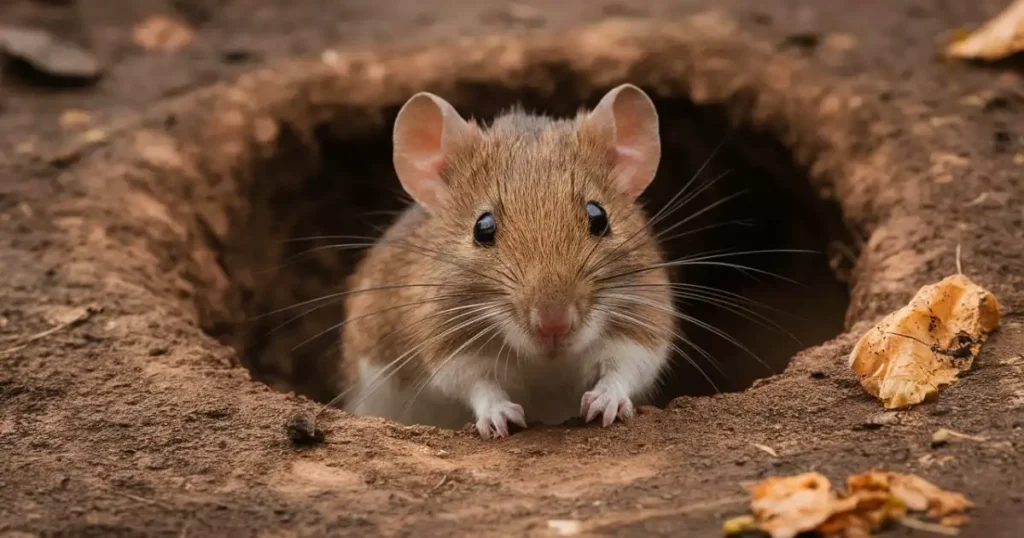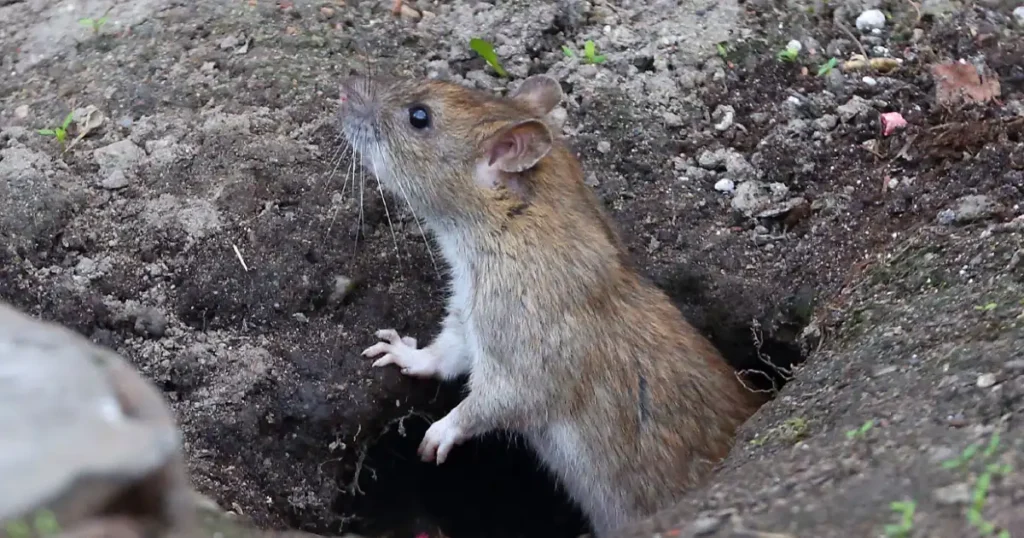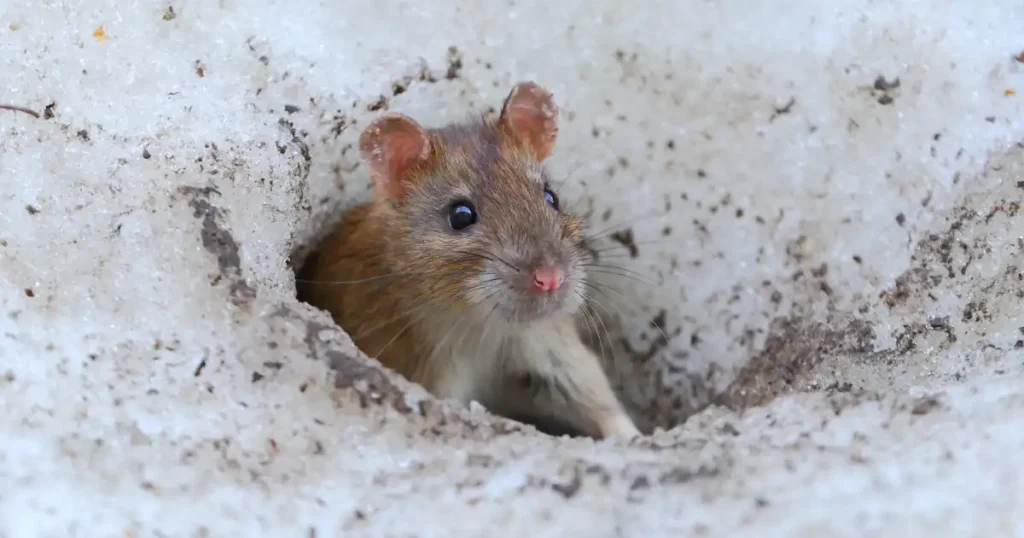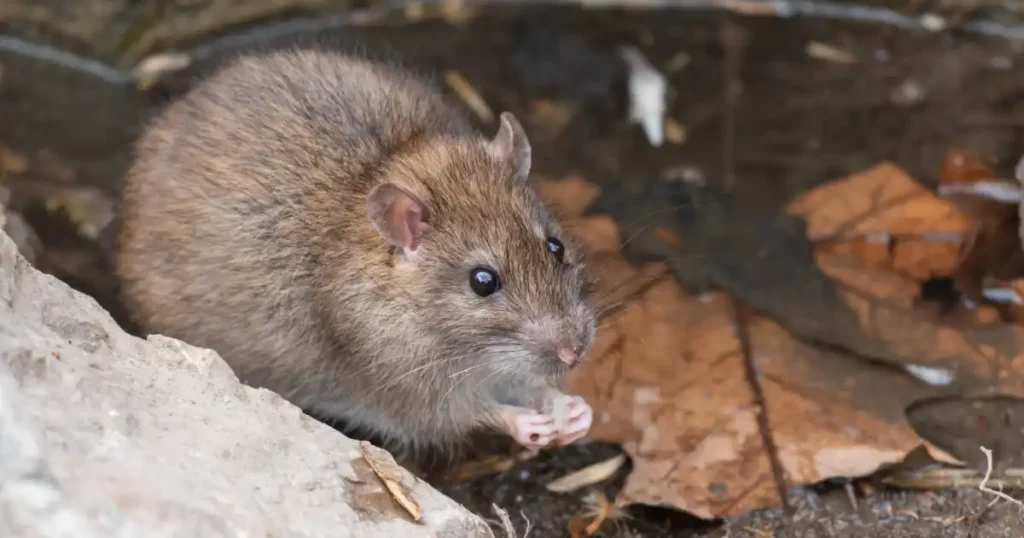
Mice are small, furry creatures that are often found scurrying around in fields, forests, and even in homes. They are known for their ability to squeeze into tight spaces and their quick movements. What people often want to know, though, is whether mice dig holes in the ground.
The answer is yes, mice do burrow in the ground. In fact, burrowing is a natural behavior for many species of mice.Burrows protect mice from animals that might eat them and the weather. They also give them a safe place to raise their young. Mice burrows can be found in a variety of locations, including fields, forests, and even in urban areas.
Mice burrows can vary in size and complexity depending on the species of mouse and the environment in which they live. Some mice may create simple burrows with just one entrance, while others may create more complex systems with multiple entrances and chambers. Regardless of the size or complexity of the burrow, it is an important part of a mouse's life and survival.
Mice are notorious for their burrowing habits, often creating intricate tunnels and nests in various locations. Understanding these habits can help address a mouse problem effectively. Here’s a detailed look at the burrowing behavior of wild mice and field mice, along with practical tips for managing a mouse infestation.
Mice burrow to create a safe and warm environment for nesting and raising their young. Their small size allows them to squeeze into tiny spaces, making holes in the ground, wood piles, and even around your home. These entrance holes are often found near food sources and water sources, making areas like the kitchen and bathroom sink prime targets.

Mice are small rodents that can be found in a variety of habitats including fields, forests, grasslands, and even urban areas. They are known for their adaptability and can thrive in a wide range of environments. While some species of mice prefer to live in trees, others are known to live in holes in the ground.This being said, if you asked yourself if do mice live in trees, the answer is correct, depending on the species.
Many species of mice use burrowing as a common survival strategy. By digging burrows, mice can create a safe and secure environment for themselves and their young. These burrows can be found in a variety of locations including fields, forests, and grasslands.
Mice can burrow in a variety of substrates including soil, sand, and even snow. Most of the time, they build complicated networks of tunnels and chambers to keep out predators and the weather.
In addition to providing protection, burrows also serve as a place for mice to store food and raise their young. One generation of mice can live safely in a well-built burrow for many years. Mice have a great ability to reproduce quickly.
Overall, burrowing is an important behavior for mice that allows them to survive and thrive in a wide range of environments.

Most mouse burrows are small holes in the ground that are about 1/2 inch to 2 inches across. Digging into the explanation to the question if do mice make holes in the ground, well, let’s add that these holes are often found near areas where mice are likely to forage for food, such as in gardens, fields, or near buildings. Certainly mices do mice dig in dirt.Most of the time, the holes are round and have smooth edges. There may be small piles of dirt or other debris around the holes.
Mice may burrow in a variety of locations, including under rocks, logs, or other debris, as well as in areas with dense vegetation. They may also burrow under buildings or other structures, creating tunnels that can lead to damage to the structure's foundation. In addition, mice may create burrows in compost piles, where they can feed on decaying organic matter.
When looking for mouse burrows, it's important to see if there are any signs of activity, like droppings or chew marks on things nearby. If you live in an area where mice are known to be active, you should also take steps to keep them out. For example, you could seal up building holes and cracks, get rid of food and water sources, and use traps or other methods of control as needed.
Overall, mice may dig holes in the ground, but it's important to know the damage they can do and take steps to stop infestations and keep populations under control when needed.

Mice are known for their ability to burrow underground. The burrows they create serve as their homes and provide protection from predators. In this section, we'll look at the inside structure of a mouse hole, including where the entrance and exit points are.
Wondering if do mice dig holes? Mice dig holes to create entrance and exit points for their burrows. These holes are typically small and can be found in a variety of locations, including under bushes, in tall grass, and near buildings. Mice may also use existing holes or cracks in buildings to gain access to their burrows.
The internal structure of a mouse burrow can vary depending on the location and the number of mice living in the burrow. Some burrows are simple tunnels, while others may have multiple rooms and chambers. The tunnels are usually narrow and can be up to several feet long.
Mice like to create tunnels to move around their burrows. These tunnels not only provide a means of transportation, but they also serve as a way to hide from predators. Mice may also create tunnels to store food and nesting materials.
In conclusion, mice are skilled at digging holes and creating burrows to serve as their homes. The anatomy of a mouse hole includes entrance and exit points and the internal structure of burrows, which can vary depending on the location and the number of mice living in the burrow.

Mice are known for their ability to dig and burrow into the ground. They use this behavior to create nests, store food, and escape predators. In this section, we will explore the digging patterns and techniques of mice, as well as their soil preferences for digging.
Mice use their front paws to dig into the ground. They have sharp claws that allow them to break through the soil easily. They typically dig in a circular motion, creating a shallow hole that is about the size of their body. Once they have created a hole, they will use their nose to push the soil out of the way.
Do mice like tunnels? They do certainly like tunnels. Mice are capable of digging tunnels that are several feet long. They will use these tunnels to move around and explore their environment. They will also use tunnels to create multiple entrances and exits to their nests.
Mice prefer to dig in loose, dry soil. They will avoid soil that is too wet or compacted. They also prefer soil that is easy to dig through, such as sandy or loamy soil.
When mice are digging for food, they will often target areas where the soil is rich in organic matter. This is because organic matter attracts insects and other small animals that mice like to eat.
In conclusion, mice are skilled diggers that use their front paws and sharp claws to create shallow holes and tunnels in loose, dry soil. They prefer soil that is easy to dig through and rich in organic matter.

Mice are known to be excellent burrowers, and they often create complex tunnel networks underground. These tunnel networks are used for many things, like hiding from animals, storing food, and keeping people safe.
Mice can dig tunnels that are several feet deep and several yards long. The depth and length of the tunnels depend on various factors, including the species of mouse, the type of soil, and the availability of food and water.
Some species of mice, such as the pocket mouse, are known to dig shallow burrows that are only a few inches deep. On the other hand, the Norway rat can dig burrows that are up to 18 inches deep and 100 feet long.
Mice create tunnel networks for a variety of reasons. One of the primary reasons is to provide shelter from predators. Predators like cats, snakes, and birds of prey can't get to mice because they dig tunnels underground.
Another reason why mice dig tunnels is to store food. Mice are known to hoard food, and they often store their food in underground burrows. Even when food is scarce, they can always count on this to give them food.
In addition to shelter and food storage, mice also use their tunnel networks for transportation. By creating tunnels that connect various areas, mice can travel without drawing the attention of any animals that might try to eat them.
Overall, mice are excellent burrowers and are capable of creating complex tunnel networks underground. These tunnel networks serve a variety of purposes, including shelter, food storage, and protection from predators.
Mice are resourceful creatures when it comes to building their nests. They use a variety of materials, including grasses, leaves, twigs, and even scraps of cloth or paper. They use their teeth to tear and cut these materials into small pieces, which they then weave together to create a cozy and secure home.
One interesting fact about mouse nests is that they often contain a layer of fur or feathers, which helps to insulate the nest and keep the mice warm. This fur or feather layer is usually taken from the mice themselves or from other animals in the area.
Mice are very secretive animals and are known for their ability to hide their nests in hard-to-reach places. They often build their nests in burrows or in other protected areas, such as under rocks, in tree hollows, or even in walls or ceilings.
To protect their nests from predators, mice will often build multiple entrances and exits, as well as tunnels and chambers within the nest itself. They may also use materials such as thorny branches or cactus spines to create a barrier around the entrance to deter predators.
Field mice often burrow under wood piles, using the stacked wood as protection. Mice can also enter through small spaces around HVAC systems, seeking warmth and shelter. Additionally, they may chew on phone and cable lines, causing damage and creating access points into homes.
Overall, mouse nests are well-constructed and provide a safe and comfortable home for these small rodents.
Mice are omnivorous and opportunistic feeders, meaning they eat both plant and animal-based foods and will consume whatever is available in their environment. They can smell food from far away because they have a strong sense of smell. Mice are known to forage for food both during the day and at night, with the availability of food, the risk of predation, and the temperature all having an impact on their foraging behavior.
When foraging for food, mice use a combination of active searching and passive sampling. Active searching involves moving around and actively looking for food, while passive sampling involves stumbling upon food while exploring their environment. Mice have also been seen to store food to eat later.
To answer a common question if do mice hide food, mice are known to hide food in their burrows as a way of storing it for later consumption. They may also store food in other locations such as tree hollows, logs, and crevices. Mice are able to remember the location of their food caches and will retrieve the food when they need it.
Food caching is important for mice as it allows them to store food during times of abundance and have a reliable food source during times of scarcity. It also allows them to reduce their exposure to predators while foraging for food.
In conclusion, mice are opportunistic feeders that forage for food both during the day and at night. They use a combination of active searching and passive sampling to locate food and are able to remember the location of their food caches. Food is stored by mice in their burrows and other places so that they can eat it later. This gives them a reliable food source when food is scarce.
Mice burrows can have a significant impact on agriculture. These burrows can damage crops by creating holes in the ground, which can cause erosion and make it difficult for plants to grow. Additionally, mice can consume crops and cause damage to stored food. Farmers may lose a lot of money because of this, and it can hurt the food supply.
Mice burrows can also cause structural damage to property. When mice burrow under foundations, they can weaken the structure and cause it to collapse. This can be particularly dangerous in buildings such as homes and businesses. Additionally, mice can chew through electrical wires and cause fires.
You should do something to keep mice from digging holes in the ground. This can be done by setting traps, sealing off entry points, and storing food properly. People can help protect their property and keep crops from getting damaged by taking these steps.
Early detection and monitoring of mouse infestations is crucial in preventing them from becoming a larger problem. Mice are nocturnal creatures, so it can be difficult to spot them during the day. But there are some things that can show that they are there, like droppings, gnaw marks, and urine stains. It is important to inspect areas where mice are likely to hide, such as behind appliances, in attics, and in basements.
Finding mouse droppings around your home is a clear sign of a mouse problem. Mice can leave strong smells from their urine and droppings, which can be quite noticeable. Numerous small holes around the property also indicate active burrowing. These signs should prompt immediate action to prevent a more serious infestation.
To prevent and control a mouse infestation, start by sealing small spaces around cable lines, HVAC systems, and other potential entry points. Traditional snap traps are effective for catching mice. Place them near entrance holes and areas with mouse activity. Reducing food sources, including keeping pet food securely stored and fixing leaks to eliminate water sources, is also essential. Regular cleaning, especially around wood piles and storage areas, can deter mice from settling in.
One effective method of monitoring mouse activity is through the use of traps.There are different kinds of traps, like live traps, glue traps, and snap traps. Most mice traps are snap traps, which are designed to kill the mouse right away. Glue traps are meant to catch mice, while live traps let you catch the mouse and let it go somewhere else.
Preventing mice from entering a home or building is the most effective way to control an infestation. Mice can get in through small holes and cracks, so it's important to seal off any places they could get in. This can be done using caulk, steel wool, or other materials.
Another effective method of control is through the use of repellents. There are several natural and chemical repellents available, including peppermint oil, mothballs, and ultrasonic devices. It's important to keep in mind, though, that repellents might not always work and should be used with other methods of control.
If an infestation is already present, it is important to take action immediately. Traps, bait, and other types of animal control can be used to do this. It is important to follow all instructions carefully and to dispose of dead mice properly to prevent the spread of disease.
Overall, preventing and managing mouse infestations requires a combination of detection, monitoring, and control strategies. By taking proactive measures and addressing infestations promptly, homeowners and building managers can effectively manage mouse populations and prevent them from becoming a larger problem.
Mice are known to burrow in the ground for various reasons, including protection from predators, nesting, and food storage. However, environmental factors like the climate and seasonal changes can have an impact on how far mice burrow.
In regions with harsh winters, mice may burrow deeper into the ground to avoid freezing temperatures. Additionally, during periods of drought, mice may burrow deeper to access moisture in the soil. Conversely, in areas with heavy rainfall, mice may burrow closer to the surface to avoid flooding.
Human activity and urbanization can also influence the extent to which mice burrow in the ground. Buildings, roads, and other forms of infrastructure can change natural habitats, which can force mice to look for shelter underground.
Furthermore, the use of pesticides and other chemicals can also impact the behavior of mice, including their burrowing habits. In some cases, mice may avoid areas where pesticides have been used, while in other cases, they may burrow deeper to avoid exposure to these chemicals.
Mice carry disease and harmful bacteria, posing health risks to humans and pets. They can contaminate pet food and other food sources, making it crucial to address an infestation promptly. The presence of mice can also attract more mice, exacerbating the problem and increasing health risks.
Overall, a variety of environmental factors can influence the extent to which mice burrow in the ground. By understanding these factors, researchers can better predict and manage mouse populations in different regions.
Scientists have been studying mouse behavior for years to understand their habits and characteristics. One of the most notable observations is that mice are burrowing animals. They often dig very complicated tunnel systems underground to stay safe and hide from animals that might try to eat them.
Studies have shown that mice burrow for various reasons, including nesting, storing food, and escaping from harsh weather conditions. They are also known to dig holes to find water, which is very important for their survival.
Mice have been observed to be very active at night, and they use their keen sense of smell and touch to navigate their way through their burrows.They are also known to be very protective of their burrows, both from other mice and animals that might try to eat them.
Advancements in rodentology have led to a better understanding of mouse behavior. Researchers have developed various techniques to study mice, including tracking devices and video surveillance.
Using genetic engineering to make mice with certain traits is one of the most important steps forward. Scientists have created mice that are resistant to specific diseases, which could potentially lead to the development of new treatments for humans.
Another significant breakthrough is the development of rodenticides, which are used to control mouse populations in areas where they are considered pests. These chemicals are designed to be effective in killing mice while minimizing their impact on the environment.
In conclusion, research and studies on mouse behavior have provided valuable insights into the habits and characteristics of these animals. Advancements in rodentology have led to a better understanding of how mice behave, and this knowledge could potentially lead to new treatments for diseases and better pest control methods.
If you were wondering what do mice holes look like, mouse holes are typically smaller in size than rat holes, measuring around 1-2 inches in diameter. Rat holes, on the other hand, are larger and can measure up to 4 inches in diameter. Additionally, rat holes are often found in more hidden areas, such as under piles of debris or in overgrown vegetation.
Small holes in the ground are a sign of a mouse burrow, which are typically shallow. Small pieces of debris and loose soil may be present around these holes. Small, tightly packed tunnels leading to and from the entrance hole can also be a sign of a mouse burrow.
One effective method for eliminating mice burrows in the yard is to remove any sources of food and shelter that may be attracting them. This can include removing piles of debris, sealing up any cracks or holes in the home's foundation or walls, and keeping garbage cans tightly sealed. Additionally, using traps or rodenticides can be effective in eliminating mice.
Yes, mice are capable of creating tunnels in the ground. However, these tunnels are typically shallow and do not extend very far. The length and extent of the tunnels will depend on the specific species of mouse and the availability of resources in the area. These explanation answer the question about if do mice dig tunnels or not.
Several species of mice are known to inhabit underground burrows, including the deer mouse, field mouse, and house mouse.
Signs of mouse activity around outdoor burrows may include small holes in the ground, small bits of debris surrounding the entrance hole, and the presence of droppings or gnaw marks on nearby objects. Additionally, mice may be heard scurrying around inside their burrows, particularly at night.
If you have a mice infestation problem in your home, it is important to seek professional help to get rid of them.
Critter Stop is a professional humane wildlife removal company that specializes in the removal of mice and other pests.
Critter Stop has a fantastic reputation and customer reviews online because it provides high quality work and great customer service. They have a team of experts who are knowledgeable and experienced in mice extermination and removal.
Contacting Critter Stop for your mice extermination services is a wise decision. Their team will conduct a free inspection to determine the extent of the infestation and the best course of action to take. They will then provide you with a comprehensive plan to get rid of the mice and prevent future infestations.
To get started with Critter Stop's mice extermination services, simply call them at (214) 234-2616. They are ready to answer your call and schedule a free inspection.
Don't let mice take over your home, contact Critter Stop today for professional mice extermination services.
Visit our Critter Library and learn more about our furry friends